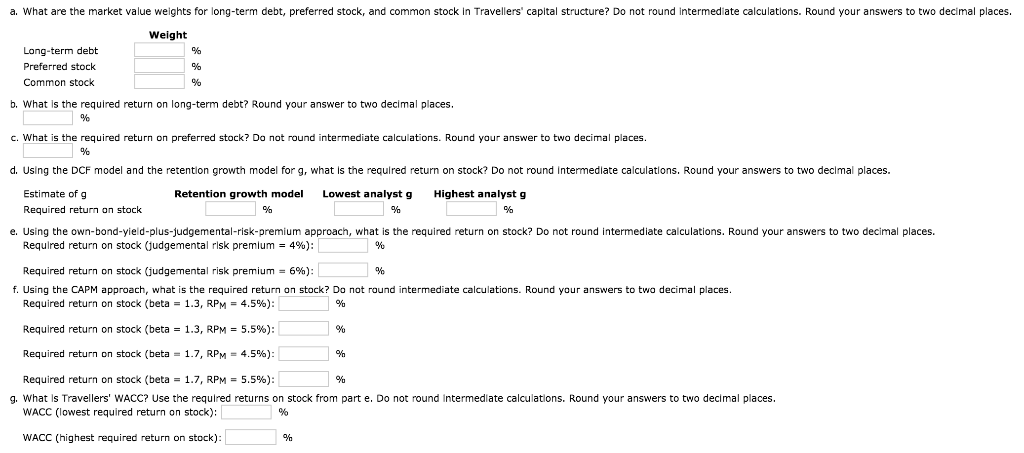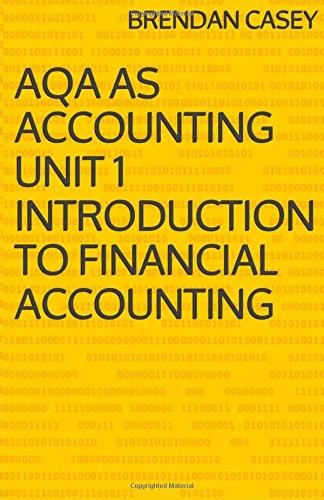

 Could you Please answer all of the questions ASAP, I am stuck on this homework problem. Thank you so much!
Could you Please answer all of the questions ASAP, I am stuck on this homework problem. Thank you so much!
79.56 WACC Estimation The following table gives the balance sheet for Travellers Inn Inc. (TII), a company that was formed by merging a number of regional motel chains Travellers Inn: (Millions of Dollars) Cash Accounts receivable Inventories $10 10 5 $25 30 $10 20 20 $50 50 Accounts payable Accruals Short-term debt Current assets Current liabilities Long-term debt Preferred stock Common equity Net fixed assets $10 30 $40 $100 Common stock Retained earnings Total common equity Total liabilities and equity Total assets $100 The following facts also apply to TII 1. Short-term debt consists of bank loans that currently cost 9%, with interest payable quarterly. These loans are used to finance receivables and inventories on a seasonal basis so bank loans are zero in the off-season. 2. The long-term debt consists of 30-year, semiannual payment mortgage bonds with a coupon rate of 8%. Currently, these bonds provide a yield to investors of rd = 12%. If new bonds were sold, they would have a 12% yield to maturity 3-TII's perpetual preferred stock nas a s 100 par value, pays a quarterly dividend of $2.50, end has a yield to investors or 11%. New perpetual preferred stock would have to provide the same yield to investors, and the company would incur a 6% flotat on cost to sell it. 4. The company has 4 million shares of common stock outstanding, Po $20, but the stock has recently traded in the price range from $17 to $23. Do $1 and EPSa $2. ROE based on average equity was 22% in the most recent year, but management expects to increase this return on equity to 31%; nowever, security analysts and investors generally are not aware of management's optimism in this regard 5. Betas, as eported by security analysts, range fro 1.3 to 17, tneT-bond rate is 996; and RPM s estimated by various brokerage houses to range f 4.5% to 5.5%. Some brokerage house analysts report forecasted dividend grow rates in the range of 10% to 15% over the foreseeable future. 6. TII's financial vice president recently polled some pens on fund investment managers who hold TII's securities regarding what minimum rate of return on TII's common would make them willing to buy the common rather than TI bonds, given that the bonds yielded 12%. The responses suggested a risk premium over TII bonds of 4 to 6 percentage points. 7. TII is in the 30% federal-plus-state tax bracket. 8. TII's principal investment banker predicts a decline in interest rates, with rd falling to 10% and the T-bond rate to 7%, although the bank acknowledges that an increase in the expected inflation rate could lead to an increase rather than a decrease In interest rates Assume tnat you were recently hired by TII as a financial analyst and that your boss, the treasurer, has asked you to estimate the company's WACC under the assumption that no new equity wll be Issued. Your cost of capital should be appropriate for use In evaluating projects that are in the same risk class as the assets TII now operates. a. What are the market value weights for long-term debt, preferred stock, and common stock in Travellers' capital structure? Do not round intermediate calculations. Round your answers to two decimal places. a. What are the market value weights for long-term debt, preferred stock, and common stock in Travellers capital structure? Do not round intermed ate calculations. Round your answers to two decimal places. Weight Long-term debt Preferred stock Common stock b. What is the required return on long-term debt? Round your answer to two decimal places. c. What is the required return on preferred stock? Do not round intermediate calculations. Round your answer to two decimal places. d. Using the DCF model and the retention growth model for g, what is the required return on stock? Do not round intermediate calculations. Round your answers to two declmal places. Estimate of g Required return on stock Retention growth mode Lowest analyst g Highest analyst g e. Using the own-bond-yield-plus-judgemental-risk-premium approach, what is the required return on stock? Do not round intermediate calculations. Round your answers to two decimal places. Required return on stock (judgemental risk premium-4%): Required return on stock (Judgemental risk premium-696) Required return on stock (beta-13, RPM-4.596) Required return on stock (beta-13, RPM-5.5%); Required return on stock (beta-17, RPM-4596) Required return on stock (beta-17, RPM 5.5%) WACC (lowest required return on stock): WACC (highest required return on stock) f. Using the CAPM approach, what is the required return on stock? Do not round intermediate calculations. Round your answers to two decimal places. g. What Is Travellers' WACC? Use the required returns on stock from part e. Do not round Intermedlate calculations. Round your answers to two decimal places. 79.56 WACC Estimation The following table gives the balance sheet for Travellers Inn Inc. (TII), a company that was formed by merging a number of regional motel chains Travellers Inn: (Millions of Dollars) Cash Accounts receivable Inventories $10 10 5 $25 30 $10 20 20 $50 50 Accounts payable Accruals Short-term debt Current assets Current liabilities Long-term debt Preferred stock Common equity Net fixed assets $10 30 $40 $100 Common stock Retained earnings Total common equity Total liabilities and equity Total assets $100 The following facts also apply to TII 1. Short-term debt consists of bank loans that currently cost 9%, with interest payable quarterly. These loans are used to finance receivables and inventories on a seasonal basis so bank loans are zero in the off-season. 2. The long-term debt consists of 30-year, semiannual payment mortgage bonds with a coupon rate of 8%. Currently, these bonds provide a yield to investors of rd = 12%. If new bonds were sold, they would have a 12% yield to maturity 3-TII's perpetual preferred stock nas a s 100 par value, pays a quarterly dividend of $2.50, end has a yield to investors or 11%. New perpetual preferred stock would have to provide the same yield to investors, and the company would incur a 6% flotat on cost to sell it. 4. The company has 4 million shares of common stock outstanding, Po $20, but the stock has recently traded in the price range from $17 to $23. Do $1 and EPSa $2. ROE based on average equity was 22% in the most recent year, but management expects to increase this return on equity to 31%; nowever, security analysts and investors generally are not aware of management's optimism in this regard 5. Betas, as eported by security analysts, range fro 1.3 to 17, tneT-bond rate is 996; and RPM s estimated by various brokerage houses to range f 4.5% to 5.5%. Some brokerage house analysts report forecasted dividend grow rates in the range of 10% to 15% over the foreseeable future. 6. TII's financial vice president recently polled some pens on fund investment managers who hold TII's securities regarding what minimum rate of return on TII's common would make them willing to buy the common rather than TI bonds, given that the bonds yielded 12%. The responses suggested a risk premium over TII bonds of 4 to 6 percentage points. 7. TII is in the 30% federal-plus-state tax bracket. 8. TII's principal investment banker predicts a decline in interest rates, with rd falling to 10% and the T-bond rate to 7%, although the bank acknowledges that an increase in the expected inflation rate could lead to an increase rather than a decrease In interest rates Assume tnat you were recently hired by TII as a financial analyst and that your boss, the treasurer, has asked you to estimate the company's WACC under the assumption that no new equity wll be Issued. Your cost of capital should be appropriate for use In evaluating projects that are in the same risk class as the assets TII now operates. a. What are the market value weights for long-term debt, preferred stock, and common stock in Travellers' capital structure? Do not round intermediate calculations. Round your answers to two decimal places. a. What are the market value weights for long-term debt, preferred stock, and common stock in Travellers capital structure? Do not round intermed ate calculations. Round your answers to two decimal places. Weight Long-term debt Preferred stock Common stock b. What is the required return on long-term debt? Round your answer to two decimal places. c. What is the required return on preferred stock? Do not round intermediate calculations. Round your answer to two decimal places. d. Using the DCF model and the retention growth model for g, what is the required return on stock? Do not round intermediate calculations. Round your answers to two declmal places. Estimate of g Required return on stock Retention growth mode Lowest analyst g Highest analyst g e. Using the own-bond-yield-plus-judgemental-risk-premium approach, what is the required return on stock? Do not round intermediate calculations. Round your answers to two decimal places. Required return on stock (judgemental risk premium-4%): Required return on stock (Judgemental risk premium-696) Required return on stock (beta-13, RPM-4.596) Required return on stock (beta-13, RPM-5.5%); Required return on stock (beta-17, RPM-4596) Required return on stock (beta-17, RPM 5.5%) WACC (lowest required return on stock): WACC (highest required return on stock) f. Using the CAPM approach, what is the required return on stock? Do not round intermediate calculations. Round your answers to two decimal places. g. What Is Travellers' WACC? Use the required returns on stock from part e. Do not round Intermedlate calculations. Round your answers to two decimal places


 Could you Please answer all of the questions ASAP, I am stuck on this homework problem. Thank you so much!
Could you Please answer all of the questions ASAP, I am stuck on this homework problem. Thank you so much!





